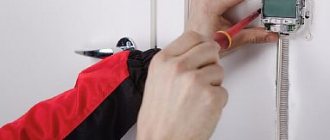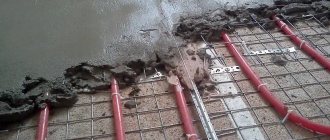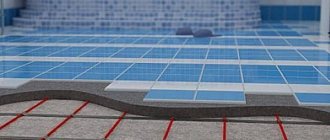Electric and water underfloor heating systems are unable to independently maintain the set temperature in the premises of a private home. The owner adapts to adjust the power of the boiler or heating circuits manually, achieving a comfortable air temperature. To organize automatic microclimate control, you need thermostats for underfloor heating (TP), installed in each room. The purpose of the publication is to describe existing types of thermostats, installation methods and connection diagrams for control devices.
Why do you need a thermostat?
It is possible to highlight the functional differences between temperature controllers in refrigerators of various types. In compression refrigerators, the device automatically turns off and on the electric motor of the compressor in accordance with the temperature in real time. Similar work is performed in absorption refrigerators, only there the heater is turned on and off.
The device is characterized by a simple structure. There is a bellows tube on the surface of the evaporator. When the evaporator temperature drops below the required value, the pressure in this tube decreases. A decrease in pressure leads to compression of the bellows, the position of the lever changes, and the electrical circuit opens.
Heating/cooling.
The easiest way to turn a heating thermostat into a cooling thermostat is a changeover contact.
Some thermostats have an option in the settings that clearly indicates that cooling work is required.
There are thermostats with separate control channels for the heater and air conditioner.
Multi-output cooling thermostats are designed for central air conditioning systems where it is necessary to control the air conditioner fan and the coolant valve of a split system.
Main varieties
Thermostats are divided into several large groups, the main ones being three. They all have a similar external structure, but differ in the temperature at which the circuit opens. This value is adjusted at the factory; it is not recommended to carry out the adjustment yourself; such an impact on the device will only lead to incorrect operation.
The type of suitable thermostat can be found in the documentation for the refrigeration equipment.
Thermostats for single-chamber refrigerators
Thermostats T-110, T-111, T-112 are mounted on refrigerators with one chamber. In terms of temperature indicators, all devices are the same, turning off is done at a temperature of -14 degrees Celsius, turning on at -12 degrees.
The thermostat models of this group differ somewhat in external characteristics. First of all, this concerns the dimensions; the handle rod and the bellows tube can have different diameters. Some models have a crossbar for easy fastening. The length of the tube can be determined by the number printed on the body. For example, 0.7 is 70 centimeters. Some thermostat models may have additional numbers and letters in the designation, T-112-1M instead of T-112.
In some cases, products are interchangeable. Using a special kit, you can install TAM-112 (new model) instead of T-110; the kit includes a nylon adapter, a nut and a fastening strip.
Thermostats for two-chamber refrigerators
Most often, for refrigerators with two chambers, thermostats are used, designated by the symbols T-130, T-132, T-133, TAM-133, TAM-133-1M.
All devices in this group turn on at +4 degrees Celsius and turn off at -14 degrees. Some products have a special strip for attachment. The handle rod and bellows tube may have different diameters, so the selection of the model is carried out according to the equipment documentation.
Thermostats for freezers
Temperature regulators T-144 and T-145 are used for installation in freezer cabinets. The T-144 thermostat differs from most models in that the manufacturer did not leave room for independent temperature control. Usually there is a special rod for this. The thermostat turns on at -20 degrees Celsius and turns off at -24 degrees.
There are four terminals on the side of the thermostat body, two of them are double terminals, this is “ground”. Terminals numbered 3 and 4 are contacts through which electricity is supplied to the compressor. A special function is performed by contact number 6; it turns on a lamp indicating that the permissible temperature standards in the chamber have been exceeded. Activation of this contact is performed at -15 degrees Celsius.
Thermostats for refrigerators "Stinol"
The selection of thermostats for refrigerators of this brand is due to the fact that devices of various models can be used for them. These are not only the TAM-133-1M and TAM-145-1M produced in our country, but also the K-57 and K-59 regulators from the manufacturer RANCO.
An important difference between thermostats for Stinol refrigerators and other models is the covering of the bellows tube with a vinyl shell. The compressor is connected through contact number 6. The temperature range of various thermostats depends on the model of the refrigerator and the device itself.
What breaks down in an oil heater
The tank is filled with heat-resistant oil to 85 - 90 percent. An air gap is left to compensate for the thermal expansion of the oil - the appropriate accordion housing configuration is selected. When refilling, choose transformer oil - you cannot mix types. Now we know the possible elements of the breakdown - we begin the repair.
The situation of a leaky tank is familiar: it worked, it worked, and it leaked. In the morning there is oil on the floor, the tank is empty, the device has turned off, the thermal fuse has burned out. It is worth using cold welding. FastFix for metal maintains temperatures from minus to +120 degrees Celsius. Take it out into the cold, carefully patched, and you can use it at home. FastFix for metal contains magnetic iron filings - the fastest setting material in the range. The master will have three minutes - in an hour the material will dry.
FastFix holds temperature, sold in pencil form: a polymerizing composition of the class of epoxy adhesives. The outer resin shell protects the inner hardener. Cut the composition of the pencil in the required amount, knead it with wet hands, and apply it in place. After hardening, smooth out the result with sandpaper, a grinder, or better yet, with a wet knife until it hardens completely. There are many puncture points - don’t forget to wear rubber gloves. Before use, wet your hands.
The oil heater is broken
Before applying a patch, the puncture site should be cleaned of paint, rust, and oil. Sand with fine sandpaper for tight adhesion. If the hole is on a section channel, try to leave a little room for oil flow. According to the manufacturer, the patches hold pressure (important for the master), or check with the manufacturer. There are many brands of liquid paint, choose your own. FastFix, which does not require thinning or spreading on the plastic with a spatula, is a good choice.
Sometimes there is a need to independently repair an oil heater with a burnt heating element. Fault identification: ring both branches with the switches turned off, the plug is pulled out of the socket. If the resistance is tens of ohms, the integrity of the core is in order. A short circuit or break indicates: the breakdown is here. The heating element is rolled inward - you will have to pull it out. The new one should be similar to the previous one. The tube used is steel, not copper, to avoid electrochemical corrosion.
Features of thermostat devices
Thermostats of different models vary in sensitivity level, which affects the range of temperature fluctuations in the refrigerator. All thermostats are essentially considered pressure gauge devices; the temperature changes the pressure of the working filler, as a result of which the device monitors changes in temperature conditions. Recently, electronic thermostats are increasingly being used in refrigerators, the operation of which depends on direct temperature measurement.
The thermostat design is simple. Its main elements are the lever mechanism and the contact circuit used for integration into the electrical circuit of refrigeration equipment. The contacts are protected from the mechanical structure using an insulating gasket.
The structure, sensitive to changes in temperature, consists of a bellows, a metal cylinder with corrugated walls. This element is elastic and can change size depending on pressure. Sometimes a membrane is used instead, to which a special tube is soldered. The essence does not change from this. Freon and chlorine metal can be used as a filler; the first is used more often, it is preferable due to its characteristics. Careful sealing of the system prevents leaks.
Freon in the system is in vapor form, its pressure changes with the ambient temperature. Freon is also present in liquid form at the end of the tube. It is that part of the tube where the boundary between the liquid and vapor form of freon lies that reacts to changes in temperature.
By temperature sensors.
- With internal sensor.
- With external sensor
- With both sensors.
Thermostats with an internal sensor measure the temperature at their installation location with their internal sensor. Not suitable for electric underfloor heating.
Thermostats with one remote sensor are designed to control the floor temperature.
If the thermostat has an internal sensor and there are terminals for an external sensor, then most likely this thermostat can still only control the temperature of the internal sensor.
An external sensor is used for emergency control of the floor temperature to prevent overheating.
Limiting the floor temperature is relevant for electric heated floors.
There were strange thermostats in which the built-in sensor served to protect the thermostat itself from overheating.
Thermoregulators that can optionally regulate either an internal or an external sensor are rare - I have only met two of these with a price of about 5,000 rubles. I would venture to suggest that thermostats costing more than 5000 rubles can all be controlled using any of the sensors.
How does a thermostat work?
Along with a change in temperature comes a change in pressure. For example, when the temperature drops, the pressure also decreases, the lever rotates under the influence of a change in the size of the membrane, and at a certain moment the electrical network opens. When the temperature rises, the lever will begin to move in the opposite direction, due to which the electrical circuit will close again.
An important role in this structure is played by the spring acting on the lever. If less force is applied to change the position of the lever, the opening will begin to occur at a lower temperature. The same can be said about increasing temperature. It is the adjustment of the required forces that affects the setting of the permissible temperature regime. In some models, a knob is used for this, but often the adjustment is made at the factory, and then adjustments cannot be made to it.
Editor's Choice
"Teplolux" BiZone
The device controls heated floors, convectors, fan coils, and heat curtains based on data from two remote floor temperature sensors in two control zones and one air temperature sensor in the device body. Sensor type TST02-2.0 or third-party sensors with resistance 10 kOhm, 12 kOhm, 15 kOhm, 33 kOhm, 47 kOhm.
"Teplolux" BiZone. Photo: Teplolux
Key features of the BiZone thermostat:
- Setting a schedule for turning on and off;
- Timer operation;
- Creating scenarios for a smart home in the Tuya Smart application;
- Control of rotation speed of fans of fan coils, thermal curtains and convectors;
- Information about energy consumption is provided in graphical form.
Thermostat operating modes are indicated by colored LEDs. To connect the device to a cloud service or smart home system, you need to scan the QR code in the device passport or on the manufacturer’s official website with your smartphone.
Specifications
| Operating temperature range | from 5°С to 45°С |
| Supply voltage | 230 V |
| Maximum power | 3.6 kW x 2 |
| Maximum control circuit current with active load | 5 A |
| Maximum control current with inductive load | IP44 |
Advantages and disadvantages
Compatible with a large number of controlled climate control devices
Not detected
Editor's Choice
Teplolux BiZone
Dual zone thermostat
Independent control of two zones remotely via WiFi via the TUYA application, integration into the smart home system and IP44 moisture protection class.
OrderDelivery terms
Signs of a broken thermostat
Determining the need to replace the thermostat is not difficult. The following signs will indicate this:
- non-stop operation of refrigeration equipment;
- the temperature in the refrigerator compartment has taken negative values;
- high temperature in the freezer;
- the equipment turns off randomly and does not turn back on for a long time (or at all).
The thermostat must be changed; such a device cannot be repaired. The regulator should be replaced after detecting the first signs of failure, otherwise incorrect temperature conditions will accelerate the spoilage of food.
Specifications
Operating parameters depend on the version, filling and control circuit. Some thermostats for quartz heaters or oil heaters are connected to 2–3 remote sensors. The built-in GSM modem carries out voice notification and electronic mailing about the state of the microclimate to specified telephone numbers indicating operating parameters.
Capabilities of modern thermostats:
- connection to eight telephone numbers and regulation of 4 alarm zones in the home;
- coordination of parameters and setting tasks via mobile communication or voice message;
- sending an SMS message when there is a power outage or low battery;
- models can withstand power of 2 - 3.5 kW.
When connecting, the current consumption of the heaters is summed up; this value should be less than the maximum value for the thermostat.
How to replace a thermostat
To replace the thermostat, you must first get to its location. In different models of refrigerators, the thermostat may be located in different places. For example, in most Atlant equipment models it is located under the door of the refrigeration compartment. Also, a thermostat is often installed in the evaporator of the chamber or in the refrigeration chamber itself.
No matter where the thermostat is installed, you need to adhere to the following algorithm of actions:
- get to the location of the thermostat;
- disconnect the capillary tube;
- carefully remove the tube from the housing;
- disconnect from the circuit and remove the thermostat;
- carefully pick up the new bellows tube and make sure it is securely fastened;
- connect all the necessary wires to connect to the network;
- install the thermostat in the appropriate place.
Professionals can handle these actions without any problems. In most cases, no special tools are required to complete the job; a Phillips screwdriver is sufficient. The operation of replacing modern electronic thermostats is a little more complicated, but in general this work is performed according to the same scheme. If you are replacing a part in a refrigerator of a brand that you have not yet encountered, it is recommended to record the actions in a photo. This will avoid errors during reassembly.
When working to replace the thermostat, you should be careful; individual parts are sensitive to careless actions. Damage can damage the thermostat and prevent it from regulating temperature. Do not forget that despite the apparent simplicity, replacing a part has its own characteristics and specifics.
Advantages of electronic heat controllers
The use of electronic thermostats and thermostats provides tangible benefits:
- Ability to coordinate the operation of several furnaces simultaneously.
- Mount sensors in any convenient place.
- Remote control from a computer or smartphone.
- Receive an alarm signal on your phone in case of problems.
Some devices are equipped with the ability to send electronic reports. Many models allow control using voice control
Not a single heating device, in this case a muffle furnace, is complete without a thermostat or thermostat. As you can see, although these devices have design differences, it would not be a big mistake to use any of these names.
Main working principle of mechanical thermostatic valve
During the operation of an industrial furnace, it is very often necessary to ensure its prompt shutdown. Mechanical thermostatic valves work by taking into account the ability of substances to change when heated.
To understand how a thermostat differs from a thermostat, we will give an example of the operation of the former based on the description of its various models.
Bimetal plates
The design of such a mechanism is incredibly simple - two plates made of a wide variety of metals, fastened with bolts. The external disk has a dial with printed temperature divisions.
Thermostat. Where to put which one.
The main principle is the dissimilar heating of metals. One plate heats up less and remains motionless, the second one bends when heated to a specific temperature.
Since the plates are part of a common electrical circuit, as long as they are even, the circuit is closed. Once a certain level of strain is reached, the circuit breaks and the electricity stops flowing.
There are many varieties of bimetallic thermostatic valves, but the operating principle is the same.
Principle of operation
The operating principle of the thermostat is simple. At the moment when the driver, the engine warms up to a certain t. To speed up the process, the coolant comes into play.
After the engine warms up, the valve is activated, the antifreeze circulates in a large circle, performing the cooling function.
It turns out that the operation of the thermostat in a car is based on the chemical properties of the ceresin found inside. At elevated temperatures, the substance melts, thereby expanding and pushing out the pin to open it. As the wax cools, it hardens and thereby causes the valve to close. Melting of the substance occurs almost instantly thanks to special additives in the composition.











